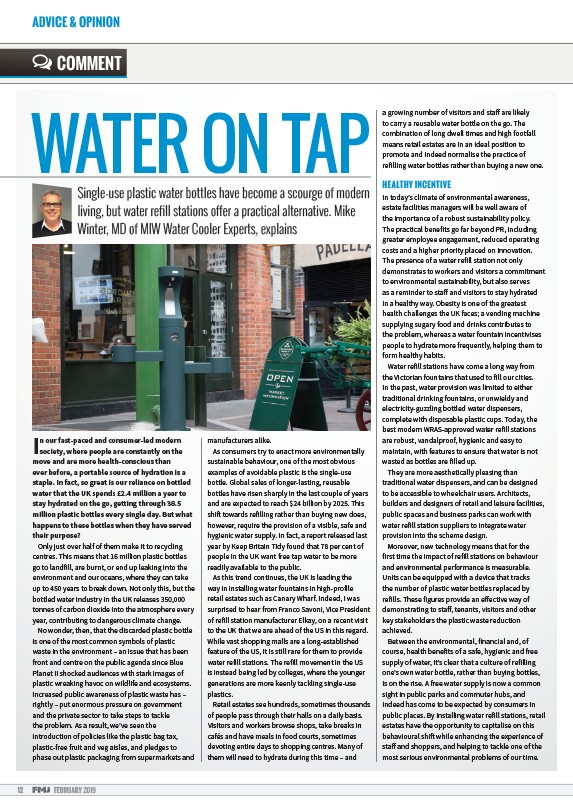
ADVICE & OPINION
COMMENT
WATER ON TAP
In our fast-paced and consumer-led modern
society, where people are constantly on the
move and are more health-conscious than
ever before, a portable source of hydration is a
staple. In fact, so great is our reliance on bottled
water that the UK spends £2.4 million a year to
stay hydrated on the go, getting through 38.5
million plastic bottles every single day. But what
happens to these bottles when they have served
their purpose?
Only just over half of them make it to recycling
centres. This means that 16 million plastic bottles
go to landfill, are burnt, or end up leaking into the
environment and our oceans, where they can take
up to 450 years to break down. Not only this, but the
bottled water industry in the UK releases 350,000
tonnes of carbon dioxide into the atmosphere every
year, contributing to dangerous climate change.
No wonder, then, that the discarded plastic bottle
is one of the most common symbols of plastic
waste in the environment – an issue that has been
front and centre on the public agenda since Blue
Planet II shocked audiences with stark images of
plastic wreaking havoc on wildlife and ecosystems.
Increased public awareness of plastic waste has –
rightly – put enormous pressure on government
and the private sector to take steps to tackle
the problem. As a result, we’ve seen the
introduction of policies like the plastic bag tax,
plastic-free fruit and veg aisles, and pledges to
phase out plastic packaging from supermarkets and
12 FEBRUARY 2019
manufacturers alike.
As consumers try to enact more environmentally
sustainable behaviour, one of the most obvious
examples of avoidable plastic is the single-use
bottle. Global sales of longer-lasting, reusable
bottles have risen sharply in the last couple of years
and are expected to reach $24 billion by 2025. This
shi towards refilling rather than buying new does,
however, require the provision of a visible, safe and
hygienic water supply. In fact, a report released last
year by Keep Britain Tidy found that 78 per cent of
people in the UK want free tap water to be more
readily available to the public.
As this trend continues, the UK is leading the
way in installing water fountains in high-profile
retail estates such as Canary Wharf. Indeed, I was
surprised to hear from Franco Savoni, Vice President
of refill station manufacturer Elkay, on a recent visit
to the UK that we are ahead of the US in this regard.
While vast shopping malls are a long-established
feature of the US, it is still rare for them to provide
water refill stations. The refill movement in the US
is instead being led by colleges, where the younger
generations are more keenly tackling single-use
plastics.
Retail estates see hundreds, sometimes thousands
of people pass through their halls on a daily basis.
Visitors and workers browse shops, take breaks in
cafés and have meals in food courts, sometimes
devoting entire days to shopping centres. Many of
them will need to hydrate during this time – and
a growing number of visitors and sta are likely
to carry a reusable water bottle on the go. The
combination of long dwell times and high footfall
means retail estates are in an ideal position to
promote and indeed normalise the practice of
refilling water bottles rather than buying a new one.
HEALTHY INCENTIVE
In today’s climate of environmental awareness,
estate facilities managers will be well aware of
the importance of a robust sustainability policy.
The practical benefits go far beyond PR, including
greater employee engagement, reduced operating
costs and a higher priority placed on innovation.
The presence of a water refill station not only
demonstrates to workers and visitors a commitment
to environmental sustainability, but also serves
as a reminder to sta and visitors to stay hydrated
in a healthy way. Obesity is one of the greatest
health challenges the UK faces; a vending machine
supplying sugary food and drinks contributes to
the problem, whereas a water fountain incentivises
people to hydrate more frequently, helping them to
form healthy habits.
Water refill stations have come a long way from
the Victorian fountains that used to fill our cities.
In the past, water provision was limited to either
traditional drinking fountains, or unwieldy and
electricity-guzzling bottled water dispensers,
complete with disposable plastic cups. Today, the
best modern WRAS-approved water refill stations
are robust, vandalproof, hygienic and easy to
maintain, with features to ensure that water is not
wasted as bottles are filled up.
They are more aesthetically pleasing than
traditional water dispensers, and can be designed
to be accessible to wheelchair users. Architects,
builders and designers of retail and leisure facilities,
public spaces and business parks can work with
water refill station suppliers to integrate water
provision into the scheme design.
Moreover, new technology means that for the
first time the impact of refill stations on behaviour
and environmental performance is measurable.
Units can be equipped with a device that tracks
the number of plastic water bottles replaced by
refills. These figures provide an e ective way of
demonstrating to sta , tenants, visitors and other
key stakeholders the plastic waste reduction
achieved.
Between the environmental, financial and, of
course, health benefits of a safe, hygienic and free
supply of water, it’s clear that a culture of refilling
one’s own water bottle, rather than buying bottles,
is on the rise. A free water supply is now a common
sight in public parks and commuter hubs, and
indeed has come to be expected by consumers in
public places. By installing water refill stations, retail
estates have the opportunity to capitalise on this
behavioural shi while enhancing the experience of
sta and shoppers, and helping to tackle one of the
most serious environmental problems of our time.
Single-use plastic water bottles have become a scourge of modern
living, but water refi ll stations off er a practical alternative. Mike
:inter, MD of MI: :ater Cooler (xperts, explains